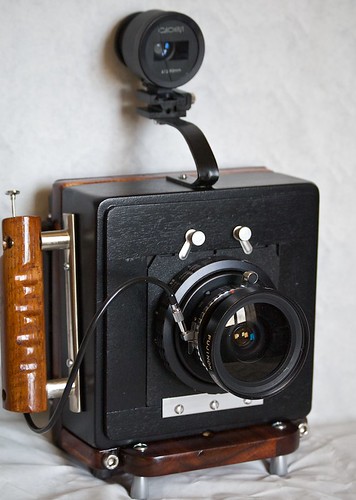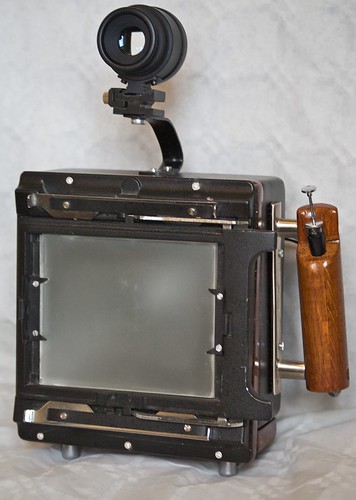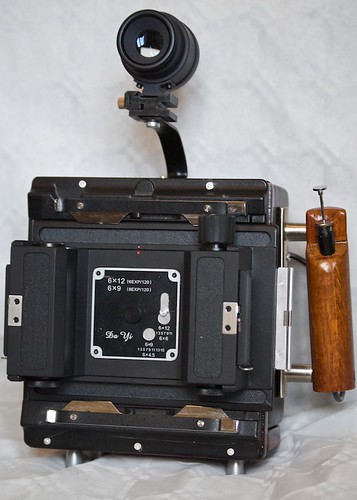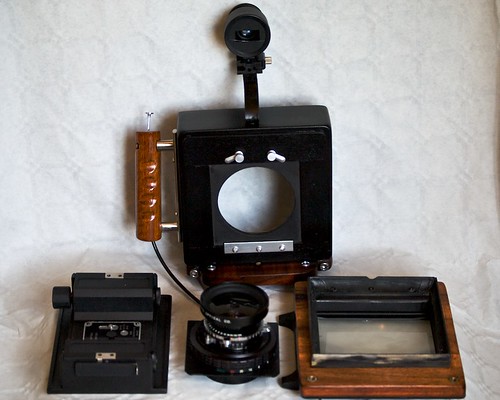 |
| Version 0.1 |
I finally decided to follow this train of thought and not let myself be led astray. I told myself I´ll be making a 4x5 point and shoot type camera, with a LF lens in Copal or Compur shutter, either hyperfocal focusing, or a helical focusing (no bellows here, not this time), built for hand held shooting, yet can also be tripod mounted and finally; no movements. All manufacturing to be done out of wood. I took inspiration from all the cameras mentioned, and then a few. But I copied none. For one thing, it can be dismantled. When I choose to add another lens, I can manufacture a new lens box and reuse the frame, back, foot and viewfinder. The handle will not be detached.




Once the important decisions were made, making the camera wasn´t that difficult. Above right, you can see the first incarnation of the camera. Fuji SW 90/f8 LF lens in a Copal #0 shutter on a helicoid of Chinese manufacture. Mounted on a Linhof type lens board. A chambre noir made out of a flower pot!. A wooden frame to which a Graflok back is attached on one side, and a sub frame come light trap on the other. The chambre noir slides over the subframe and friction holds the two together. A foot added to fill out the space left over, a handle on the right hand side made out of oak.
The viewfinder is raised up so that the roll-film back will not gash my nose, since found unnecessary and modified. Above left you can see the Graflok back with ground glass inserted. And to its right, with the DAYI 6x12 back attached. Below right you can see the different components before assembly. Can be taken apart again in 2 minutes.
 However, once put together, and taken out for a test run, there were a few things that needed doing. One, the viewfinder need not be mounted up high (added to parallax issues) the handle was too small and mounted too close the the body. Three, the unavoidable light leak. More on this later.
However, once put together, and taken out for a test run, there were a few things that needed doing. One, the viewfinder need not be mounted up high (added to parallax issues) the handle was too small and mounted too close the the body. Three, the unavoidable light leak. More on this later.
 However, once put together, and taken out for a test run, there were a few things that needed doing. One, the viewfinder need not be mounted up high (added to parallax issues) the handle was too small and mounted too close the the body. Three, the unavoidable light leak. More on this later.
However, once put together, and taken out for a test run, there were a few things that needed doing. One, the viewfinder need not be mounted up high (added to parallax issues) the handle was too small and mounted too close the the body. Three, the unavoidable light leak. More on this later.How do you do it? Well its not difficult really. All you need to make a functional camera is to have a lens, a film holder or transport, a light tight box, a shutter, and the lens mounted at the correct distance to the film plane. Lens, shutter, helicoid and film holder were all purchased from ebay. The viewfinder too, but I could have made one from say a door peep hole lens, or similar. The light tight box is just that a box, open at one end and a fitting for the lens board at the other. The distance from the rear of the shutter to the film plane should be 99.1mm for this particular lens. In practice there may be sample variation, which is why collimating the lens is important. More about that later, too. Tools and materials used:
- Saw and mitre box
- Wood files
- Sandpaper 60, 120, 180 and 600
- Screwdrivers
- Drill and drill bits
- Sander
- Spirit level
- Calipers
- Carpenter´s square
- Auto paint, wood stain and lacquer
- Wood glue
- Assorted woods, a chopping board as frame, oak handle, fir chambre noir.
- Cupboard door handles and knobs
- Screws, nuts and bolts.
No comments:
Post a Comment